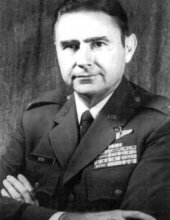Has a Death Occurred? We Are Available 24/7  (719) 207-8855
(719) 207-8855

Has a Death Occurred? We Are Available 24/7  (719) 207-8855
(719) 207-8855






Obituary


Obituary of Col. Kennith Frank Hite, USAF,
Col. Kennith Frank Hite, USAF, (Ret.), passed away on November 21, 2019. He was born on July 16, 1926 in Vernon, Texas where his father, Robert Parks Hite, took him on his first airplane ride at the age of five, in a corrugated aluminum Ford Trimotor airliner. His love of airplanes and flying never diminished. Later in Earth, in West Texas, he graduated from Spring Lake High School. There, on the family farm at the dawning of WWII, the frequent sight of DC-2s and DC-3s overhead on the airway from Amarillo to El Paso kept alive his dreams of becoming an engineer and airplane pilot. His brother, Robert L. Hite, (born in 1920) entered flight school. His participation in America's first offensive air strike against Japan, the "Doolittle Raid', in retaliation for Japan's earlier attack on Pearl Harbor, Hawaii, identified all sixteen aircrews as heroes. In the meantime, their sister, Hazel, married a Naval Aviator, Lt. JG Jack Ricketts, who flew submarine patrol over Pacific Combat areas in the PBY flying boat and a B-24 that was equipped with torpedoes and bombs suitable for submarine attack.The route for Ken was circuitous: first a year studying Engineering at Texas Technological College, Lubbock, Texas; then entry into the Army Air Corps. At age eighteen he qualified as an Aviation Cadet. He was an "on-the-line-trainee" pending a flying class assignment when WWII ended. He returned to Texas Tech to continue his studies until appointed in 1947 by The Honorable George Mahon to the U.S. Military Academy Class of 1951 at West Point, New York. At West Point, Ken served in the Command Structure of Company H-1 and earned a major "A" with Navy Star as a sprinter on the track team. He was a member of the Honor Committee, Skeet Club, Ski Club, and served on the Public Information and Yearbook Committees. His West Point roommate, Allan Parker Hunt, recalled that "�. Ken found no obstacle in either Cadet life or academics. He has a thoroughness, determination and warm sincerity that make him a winner, with many admirers and still more friends�."Upon being graduated, good fortune smiled! In the absence of an Air Force Academy in 1951, USMA cadets were given the opportunity to choose the armed service of their choice (Army, Navy, Air Force, or Marines). About one fourth of the class met Air Force physical requirements for flight training and chose the Air Force. It was an extremely gratifying choice for Ken. Also, he had found "his one and only" and at that juncture married Margaret Fletcher, a New York native. After a two month leave and honeymoon, Ken reported in for flight school in the propeller driven AT-6. Next, he was assigned to Williams AFB, Arizona, and F-80 Jet Fighter training. Upon Ken's graduation, Robert L. Hite flew down in his B-25 Medium Bomber to pin on Ken's wings and present him with his graduation certificate.Ken was transferred to Nellis Air Force Base, Nevada, where he learned to fly and fight, flying another jet, the single seat, F-86 Saberjet swept wing fighter. Training included jet fighter tactics, gunnery with the six fifty caliber machine guns and dropping practice bombs. After graduation he learned his flight mate and himself were going to the 4th Fighter Interceptor Wing Kimpo, Korea. They got to pick the squadron of their choice. Ken chose the 334th Fighter Squadron. The primary mission was to shoot down the Russian made swept wing fighter, the MIG-15, and escort U.S. and Allied Reconnaissance aircraft and Fighter Bombers. The job as a wingman was not to be a shooter but to provide another set of eyeballs to identify enemy aircraft and protect the older, more experienced shooters. Even so the day Ken was checked out to be a flight leader, he was able to split S and get behind a MIG-15 and shoot it up pretty badly/ last seen with smoke and fire trailing. The MIG turned north toward Manchuria/ disappeared into the clouds. If he crashed or bailed out it was a kill. Ken took conservative credit and called it a severely damaged MIG-15. He had flown ninety combat missions when a truce between North Korea and the United Nations Forces was signed. Ken remained in fighters and was reassigned to Nellis Air Forces bases as a Combat Crew and Fighter Weapons Instructor. He flew and instructed in the F-86-F and F-100-D.Next, he joined the original staff and faculty of the new US Air Force Academy at Colorado Springs, Colorado in March 1957. There as a member of the Commandants Staff he guided cadets through educational field trips throughout the U.S. Air Force and prior to graduation, appropriate NATO military and political units throughout Northern Europe: conceived, wrote, and taught relevant classroom courses. The Soviet Union had developed and launched its first space creation into Earth's orbit named Sputnik. This inspired Ken who then conceived, developed, wrote, and taught an advanced course to all Cadets: entitled "Aerospace Power in Modern War". The course became a key element of the Military Studies curriculum. For this and other such contributions he was congratulated and awarded the Air Force "Commendation Medal" with an Air Force citation.In 1961 he proceeded to the 18th Tactical Fighter Wing, Kadena, Okinawa as a war planner for two years where he also became combat ready in the F-100-D and F-105-D. Then, a two-year tour at Pacific Air Force Headquarters, as the fighter attack/strike planner for all Pacific Air Force tactical fighter wings in the Pacific Ocean area. This was followed by assignment to Nellis AFB, Nevada as a Combat Crew instructor Pilot and Chief, Wing Command Post.After these years of preparation, it was indeed a thrill to Ken when he received an assignment in November 1966 to a Southeast Asia combat wing, the 388th Tactical Fighter Wing as commander, 421st Tactical Fighter Squadron late renamed the 44th TFS. Just a name change: both located at Korat Royal Thai Air Base, Thailand. Our mission was to fly the F-105-D and F-105-F Wild Weasel against the Russian Air Defense system provided to North Vietnam. The "D" was used to strike "bomb" steel mills, factories, oil storage sites, ammunition storage sites, highways, railroads, bridges and infrastructure used to bring supplies from Russia and China. The "F" Wild Weasel was used to attack Russian Surface to Air Missiles- the SA-2 designed to shoot down airplanes. The Russian air defense system was the toughest the US Air Force had ever faced. Losses were high at times; however, no North Vietnamese target was safe from our air strikes. We did not lose the air war, but the political negotiators did it for us! The only happy moment was when we regained control of our many U.S. prisoners of war and brought them home! May God bless them!On May 17, 1967 he was transferred from Thailand to Germany and a NATO assignment as the attack strike planner for 4th Allied Tactical Air Force, Ramstein Air Base, West Germany. After a year at 4 ATAF he took command of the 81st Tac Ftr Squadron at Hahn AFB, West Germany and flew F-4-D until selected for study at the National War College, Washington D.C. from which he was graduated in 1970, and in 1970 at the same time earned a Master's Degree in �International Affairs" from George Washington University, Washington D.C.Next, Ken was assigned to the Joint Chiefs of Staff, Plans and Policy, far East Division. This gave him the elite opportunity to participate in the interagency development of our new "U.S. Policy Toward Japan." The President U.S.A. had recognized the residual sovereignty of the island of Okinawa Japanese control. As the Joint Chief's of Staff Pentagon representatives of the JCS Okinawa Reversion Treaty in Washington's Pentagon Ken developed and negotiated with U.S. Army, Navy, Air Force and Marine Corp. to develop plans and policy to be negotiated with the Japanese Government by U.S. Navy Vice Admiral Curtis, our Tokyo based representative who was prestigiously provided with space on the top floor of the new Tokyo Hotel where he lived and officed for this event. These negotiations were carried out on a Quid Pro Quo basis with Japanese representatives. For everything we gave up we received something of equal or better value. For his part, Ken and Margaret were invited to attend the formal U.S. approval and signing of the Treaty at the U.S. State Department in 1972. Ken was on the Air Force Brigadier Generals list with an interim assignment to the National War College pending the date of his promotion, then a likely assignment as Wing Commander at Luke Air Force Base, Phoenix, Arizona. However, he put his wonderful family first: Robert Douglas, Suzanne and Holly, were at an age that Ken thought needed both mother and father's attention. Kennith considered it a gratifying and wonderful career but chose other means to finish his service to our country. Kennith F. Hite served in World War II, ten months; Aviation Cadet, two years; Reserve, twenty-eight years active; USAF: Fighter Pilot-Korea/Vietnam, 203 total combat missions, totaling thirty-one years of service. God bless America. He was awarded the Silver Star for Gallantry in Action, 2 Legions of Merit, 3 Distinguished Flying Crosses, 10 Air Medals, 2 Air Force Commendation Medals, and 1 World War II Victory Medal.Ken and Margaret retired to Lubbock, Texas in 1979 where he participated in community and civic activities including The Lubbock Apartment Association, The Chamber of Commerce, and The Round Table. He was a member of First Baptist Church, The Lubbock Club, The Military Officers Association, The Daedalians, and Red River Pilots Association. His life is recorded at the Southwest Collection where he contributed his Military Memorabilia as well as to the Vietnam Collection at Texas Tech.During this time of his life he enjoyed hunting and boating including several memorable houseboat trips to Lake Powell with his outdoorsman cousin, Avon, and their wives, learning about the ancient Anaszi's and discovering Hite's Landing. Special memories Holly recalls are fishing from his Skagit on Lake Mead and playing with the water dogs. The flight from Oahu to Maui on a Beechcraft Bonanza is one of Doug's favorite memories. Suzanne treasures learning how to ride a bike and water ski from her dad and her introduction to tumble weeds when he brought her to Texas Tech and most recently celebrating the 50th anniversary of the United States Air Force Academy in April 2009. Margaret and the entire family loved the ski trip to Austria in 1969. He is greatly missed.Kennith is preceded in death by his parents, Robert P. Hite and Lena D. Hite; brother, Robert L. Hite; grandson, Chris "Cowboy" Slagle; nephew, Ken Ricketts; and cousin and great friend, Avon Flaniken, M.D.He is survived by his beloved wife of sixty-eight years, Margaret; his children, Suzanne M. Hite, M.D. of Houston, Robert Douglas Hite of Austin, Holly (Jim) Begeal of Clifton; and sister, Hazel Ricketts of Scottsdale. He also leaves behind his granddaughter, Heather Slagle; great-grandchildren, Jacelyn, Heidi, and Chris; nieces, Paulan Ricketts, Catherine Landers; nephews, Rick Ricketts and Wallace Hite; cousins, Bob Bryant and Richard Hite; and many cousins, great-nieces and nephews.We wish to express a special thanks to Adela Reyes and Lupe Ybarra, his caregivers the past year.Funeral Service, 10:00AM, Tuesday, December 17, 2019, USAF Community Chapel, 5134 Cathedral Drive, U.S. Air Force Academy, Colorado 80840.Interment, USAF Academy Cemetery, USAF Academy, Colorado 80841.In lieu of flowers, memorial contributions in Ken's memory may be made to the United States Air Force Academy Endowment Fund or the Daedalians.
Events
Funeral Service
Tuesday, December 17, 2019
10:00AM
United States Air Force Academy Community Center Chapel
5134 Cathedral Drive, Suite 100
United States Air Force Academy, CO 80840
Phone: 719-328-1793
Final Resting Place
United States Air Force Academy Cemetery
Colorado Springs, CO
To send flowers to the family or plant a tree in memory of Col. USAF,, please visit Tribute Store

A Memorial Tree was planted for Col.
We are deeply sorry for your loss ~ the staff at The Springs Funeral Services



Copyright © 2024 | Terms of use & privacy policy
